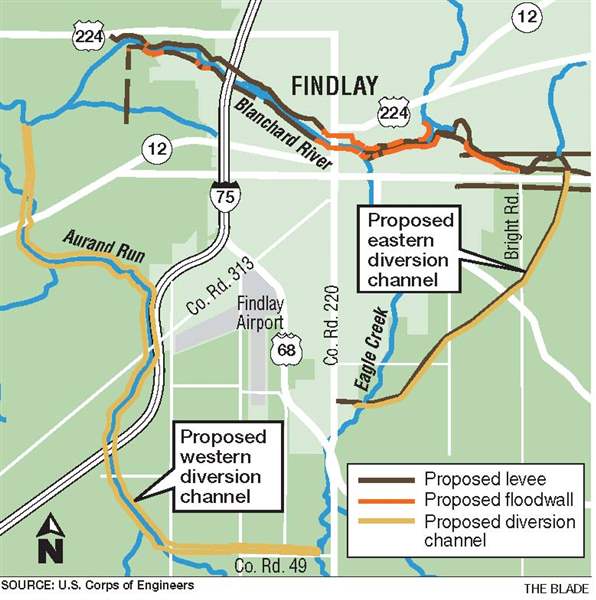
Findlay flood control could cost over $107 million
9/29/2009
FINDLAY - Putting a plug on the flooding problem in the Blanchard River Watershed could cost an estimated $107 million "plus or minus 50 percent," an official with the U.S. Army Corps of Engineers said Monday night.
Phil Berkeley, who works in the planning branch of the Corps' Buffalo, N.Y., district office, said the cost estimates that his agency has come up with are very preliminary because none of the proposed flood control options has been decided.
"That number will change just as this plan will change," he said.
Mr. Berkeley made his comments at a well-attended public meeting at Winebrenner Seminary where local officials laid out a conceptual engineering plan to control flooding in Findlay, which was inundated with a 100-year flood in August, 2007, and hit hard again five months later.
Any flood-control plan probably would include building a diversion channel that would send overflow water from Eagle Creek, which feeds into the Blanchard River near downtown Findlay, around the city either to the west along an existing creek or to the east, residents were told last night. Such a channel was proposed back in 1962
In addition to a diversion channel, the plan calls for detention ponds and wetlands in some areas that historically flood, floodgates at key points, and a series of earthen levees and flood- walls along the river as it passes through the downtown area.
Findlay City Engineer Brian Hurt said earthen mounds could be constructed up and around the city-owned Swale Park and former Brandman tire dump property. The property, which once was eyed for a residential and commercial development, regularly floods and makes for a natural detention area, he said.

"In some areas in the downtown you'll have to go with floodwalls," Mr. Hurt said. "We just don't have the room for levees without tearing down multiple structures that serve a great purpose for businesses."
Mr. Hurt, who likes to call the watershed "topographically challenged" because of its flatness,
said another important part of the plan would be building levees on both sides of Dr. Martin Luther King Parkway. He said that would give emergency vehicles and other traffic another point to cross the river during a flooding event.
Hancock County Engineer Steve Wilson said businesses want to see flooding controlled not only so they can keep operating during high-water events but so that their employees can get to work. The proposed western diversion channel, he said, would begin south of State Rt. 15 and keep that route from being water-covered and impassable as it was in 2007.
"We're not just trying to protect businesses, homes, and people's property," Mr. Wilson said. "We're trying to set up a program that would control the floodwaters so goods and vehicles can move, so emergency vehicles can move, so we can get people where they need to be."
The Northwest Ohio Flood Mitigation Partnership was created shortly after the 2007 flood with donations from a number of local corporations in Hancock and Putnam counties. They are working to see a flood control plan in place in three years rather than the five years it normally takes. Their goal is to secure 65 percent federal funding for the project and begin construction by 2012.
Tony Iriti, president of the partnership, told the crowd his group was no longer going to promote the idea of forming a Blanchard River watershed conservancy to implement and maintain the flood-control measures. He said it will be up to local elected officials to decide who will do that and how it will be paid for.
"We still believe a conservancy district is the best vehicle to do that, but we're going to leave that up to the elected officials," he said. "That is no longer part of our program."
Last year, Hancock County commissioners implemented a 0.25 percent sales tax earmarked for flood mitigation. The tax will be on the November ballot for voters to renew, and Scott Malaney, a member of the partnership's board, said the partnership supports the tax as a way to pay for the multimillion dollar plan "a little bit at a time over time."
For nearly an hour, the panel fielded questions from the audience, many of which dealt with paying for the project.
Mr. Wilson said the 0.25 percent sales tax could generate about $25 million over 10 years and go a long way toward paying the local share of the project.
Some members of the public left the meeting wanting to know more but hoping for the best.
"I'm glad to see they're making progress, but I expected to hear more definitive plans than we did," said Findlay resident Judy McCrory.
Although officials are cognizant of how the flood measures would look - they prefer to build levees rather than floodwalls wherever possible, because they're about a third of the cost - Mr. Iriti said before the meeting that the partnership is not proposing a "Taj Majal" plan.
Some communities, like Napa, Calif., incorporated recreational and economic development issues as part of flood mitigation, but local officials want to achieve the best result without excessive spending, Mr. Iriti said.
"We believe that if we can protect properties from flooding, the redevelopment is going to take care of itself," he said.
Contact Jennifer Feehan at:
jfeehan@theblade.com
or 419-724-6129.